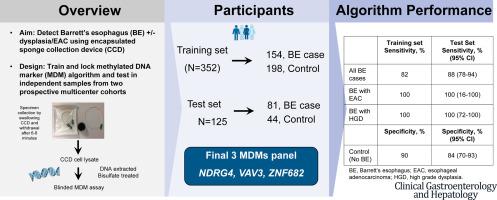当前位置:
X-MOL 学术
›
Clin. Gastroenterol. Hepatol.
›
论文详情
Our official English website, www.x-mol.net, welcomes your feedback! (Note: you will need to create a separate account there.)
Algorithm Training and Testing for a Nonendoscopic Barrett’s Esophagus Detection Test in Prospective Multicenter Cohorts
Clinical Gastroenterology and Hepatology ( IF 12.6 ) Pub Date : 2024-03-19 , DOI: 10.1016/j.cgh.2024.03.003 Prasad G. Iyer , Seth W. Slettedahl , Douglas W. Mahoney , Maria Giakoumopoulos , Marilyn C. Olson , Martin Krockenberger , William R. Taylor , Patrick Foote , Calise Berger , Cadman Leggett , T.T. Wu , Eduardo Antpack , Gary W. Falk , Gregory G. Ginsberg , Julian A. Abrams , Charles J. Lightdale , Francisco Ramirez , Allon Kahn , Herbert Wolfsen , Vani Konda , Arvind J. Trindade , John B. Kisiel
Clinical Gastroenterology and Hepatology ( IF 12.6 ) Pub Date : 2024-03-19 , DOI: 10.1016/j.cgh.2024.03.003 Prasad G. Iyer , Seth W. Slettedahl , Douglas W. Mahoney , Maria Giakoumopoulos , Marilyn C. Olson , Martin Krockenberger , William R. Taylor , Patrick Foote , Calise Berger , Cadman Leggett , T.T. Wu , Eduardo Antpack , Gary W. Falk , Gregory G. Ginsberg , Julian A. Abrams , Charles J. Lightdale , Francisco Ramirez , Allon Kahn , Herbert Wolfsen , Vani Konda , Arvind J. Trindade , John B. Kisiel

|
Endoscopic Barrett’s esophagus (BE) and esophageal adenocarcinoma (EAC) detection is invasive and expensive. Nonendoscopic BE/EAC detection tools are guideline-endorsed alternatives. We previously described a 5-methylated DNA marker (MDM) panel assayed on encapsulated sponge cell collection device (CCD) specimens. We aimed to train a new algorithm using a 3-MDM panel and test its performance in an independent cohort. Algorithm training and test samples were from 2 prospective multicenter cohorts. All BE cases had esophageal intestinal metaplasia (with or without dysplasia/EAC); control subjects had no endoscopic evidence of BE. The CCD procedure was followed by endoscopy. From CCD cell lysates, DNA was extracted, bisulfite treated, and MDMs were blindly assayed. The algorithm was set and locked using cross-validated logistic regression (training set) and its performance was assessed in an independent test set. Training (N = 352) and test (N = 125) set clinical characteristics were comparable. The final panel included 3 MDMs (NDRG4, VAV3, ZNF682). Overall sensitivity was 82% (95% CI, 68%–94%) at 90% (79%–98%) specificity and 88% (78%–94%) sensitivity at 84% (70%–93%) specificity in training and test sets, respectively. Sensitivity was 90% and 68% for all long- and short-segment BE, respectively. Sensitivity for BE with high-grade dysplasia and EAC was 100% in training and test sets. Overall sensitivity for nondysplastic BE was 82%. Areas under the receiver operating characteristic curves for BE detection were 0.92 and 0.94 in the training and test sets, respectively. A locked 3-MDM panel algorithm for BE/EAC detection using a nonendoscopic CCD demonstrated excellent sensitivity for high-risk BE cases in independent validation samples. (Clinical trials.gov: , .)
中文翻译:

前瞻性多中心队列中非内窥镜巴雷特食管检测测试的算法训练和测试
内镜巴雷特食管 (BE) 和食管腺癌 (EAC) 检测是侵入性的且昂贵。非内窥镜 BE/EAC 检测工具是指南认可的替代品。我们之前描述了在封装的海绵细胞收集装置 (CCD) 样本上测定的 5-甲基化 DNA 标记 (MDM) 组。我们的目标是使用 3-MDM 面板训练新算法,并在独立队列中测试其性能。算法训练和测试样本来自 2 个前瞻性多中心队列。所有BE病例均有食管肠化生(伴或不伴不典型增生/EAC);对照受试者没有 BE 内窥镜证据。 CCD 程序之后是内窥镜检查。从 CCD 细胞裂解物中提取 DNA,进行亚硫酸氢盐处理,并对 MDM 进行盲法分析。该算法使用交叉验证的逻辑回归(训练集)进行设置和锁定,并在独立的测试集中评估其性能。训练集 (N = 352) 和测试集 (N = 125) 的临床特征具有可比性。最终小组包括 3 个 MDM(NDRG4、VAV3、ZNF682)。特异性为 90% (79%–98%) 时,总体敏感性为 82% (95% CI, 68%–94%);特异性为 84% (70%–93%) 时,总体敏感性为 88% (78%–94%)。分别是训练集和测试集。所有长段和短段 BE 的灵敏度分别为 90% 和 68%。在训练和测试集中,对高度不典型增生的 BE 和 EAC 的敏感性为 100%。非发育不良 BE 的总体敏感性为 82%。在训练和测试集中,BE 检测的受试者工作特征曲线下面积分别为 0.92 和 0.94。使用非内窥镜 CCD 进行 BE/EAC 检测的锁定 3-MDM 面板算法在独立验证样本中表现出对高风险 BE 病例的出色灵敏度。 (临床试验.gov:,。)
更新日期:2024-03-19
中文翻译:

前瞻性多中心队列中非内窥镜巴雷特食管检测测试的算法训练和测试
内镜巴雷特食管 (BE) 和食管腺癌 (EAC) 检测是侵入性的且昂贵。非内窥镜 BE/EAC 检测工具是指南认可的替代品。我们之前描述了在封装的海绵细胞收集装置 (CCD) 样本上测定的 5-甲基化 DNA 标记 (MDM) 组。我们的目标是使用 3-MDM 面板训练新算法,并在独立队列中测试其性能。算法训练和测试样本来自 2 个前瞻性多中心队列。所有BE病例均有食管肠化生(伴或不伴不典型增生/EAC);对照受试者没有 BE 内窥镜证据。 CCD 程序之后是内窥镜检查。从 CCD 细胞裂解物中提取 DNA,进行亚硫酸氢盐处理,并对 MDM 进行盲法分析。该算法使用交叉验证的逻辑回归(训练集)进行设置和锁定,并在独立的测试集中评估其性能。训练集 (N = 352) 和测试集 (N = 125) 的临床特征具有可比性。最终小组包括 3 个 MDM(NDRG4、VAV3、ZNF682)。特异性为 90% (79%–98%) 时,总体敏感性为 82% (95% CI, 68%–94%);特异性为 84% (70%–93%) 时,总体敏感性为 88% (78%–94%)。分别是训练集和测试集。所有长段和短段 BE 的灵敏度分别为 90% 和 68%。在训练和测试集中,对高度不典型增生的 BE 和 EAC 的敏感性为 100%。非发育不良 BE 的总体敏感性为 82%。在训练和测试集中,BE 检测的受试者工作特征曲线下面积分别为 0.92 和 0.94。使用非内窥镜 CCD 进行 BE/EAC 检测的锁定 3-MDM 面板算法在独立验证样本中表现出对高风险 BE 病例的出色灵敏度。 (临床试验.gov:,。)



























 京公网安备 11010802027423号
京公网安备 11010802027423号